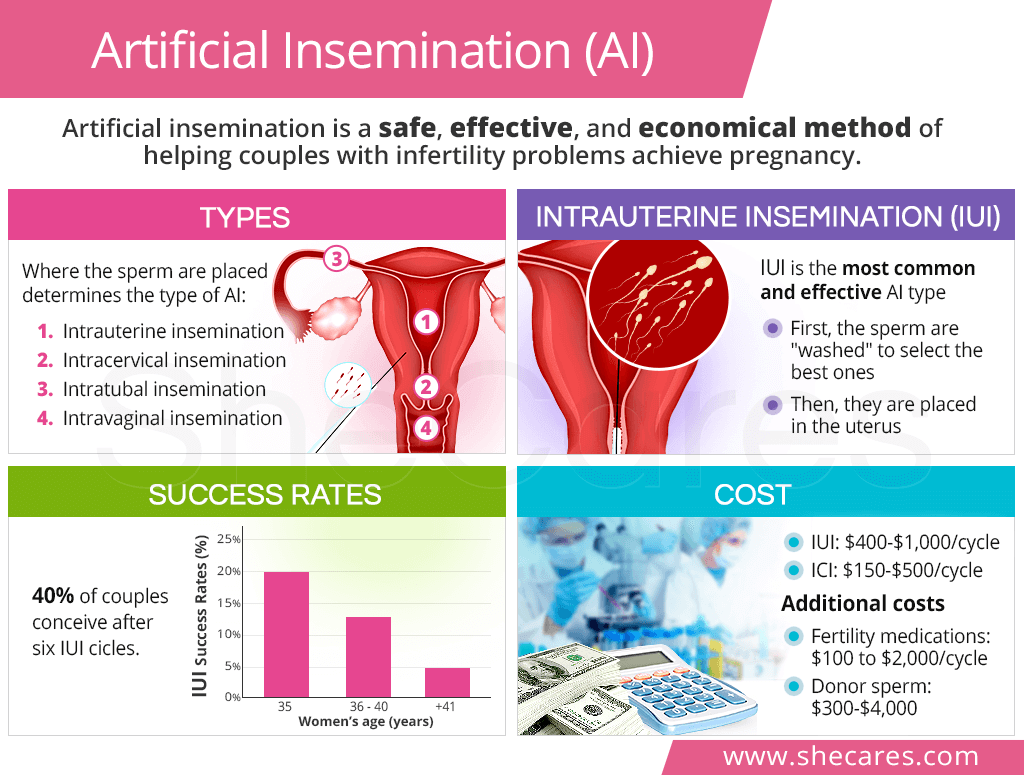What is Artificial Insemination?
Artificial insemination, often called artificial fertilization, is a type of assisted reproductive technology (ART), which consists of placing sperm directly into the female reproductive tract to encourage fertilization. As such, it is one of the methods to treat infertility.
Because the journey of the sperm to the egg is difficult, the majority of the sperm cells never make it. The main goal of AI is to shorten the path the sperm has to travel and reduce the risk of various factors potentially disturbing them en route, thus increasing the chance of fertilization.
Who Can Benefit from Artificial Insemination
Artificial insemination is usually the first course of action for couples who haven't conceived naturally after 12 months of trying, or after 6 months of trying if a woman is older than 35.
Artificial insemination is also an option for women who still have decent ovarian reserves so that they can use their own eggs. It has been found especially beneficial in the following scenarios:
Women who have endometriosis
Women who have cervical complications
Partners with sperm deficiencies, such as low motility
Partners with sexual dysfunction
Couples with unexplained infertility
Same-sex couples and single women wishing to get pregnant
AI might not be a suitable option for women older than 40, those passing through the menopausal transition, or those with damage or blockage to the reproductive organs.
Types of Artificial Insemination
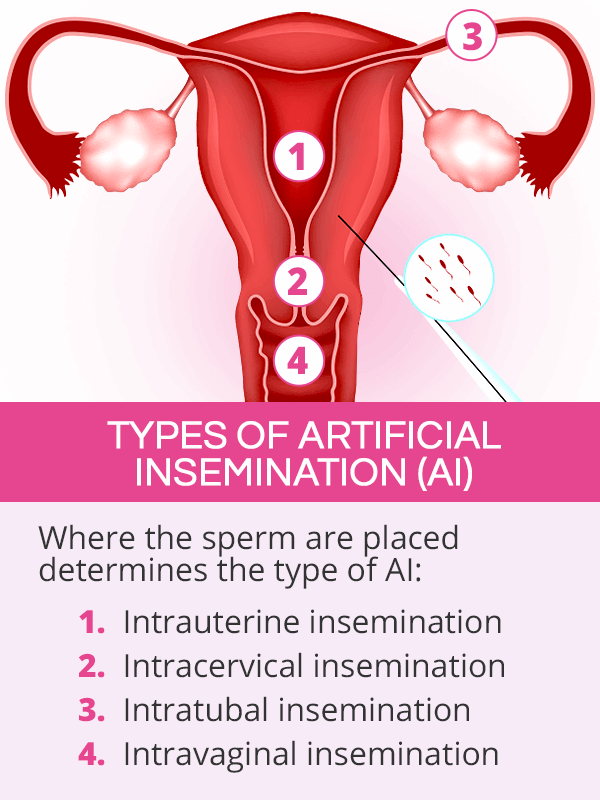
All types of artificial insemination procedures follow roughly the same steps: the sperm are obtained from a woman's partner or a donor and placed her reproductive tract.
The four types of artificial insemination are, however, distinguished depending on where within the tract those sperm are placed. They include the following:
Intrauterine insemination (IUI) is the placement of healthy, motile sperm in the uterus after they have been “washed” or separated from components that might interfere with conception. It is the most common and effective of all AI procedures.
Intracervical insemination (ICI) is the second most popular AI procedure, during which the semen is placed in the cervix. Although the semen does not have to be “washed” prior to insemination, adding that extra step is believed to increase the chances of conception.
Intratubal insemination is further divided into two subtypes, which consist of either placing the sperm in the fallopian tubes or their entrance. Due to the fact that it is significantly more invasive and costly, intratubal insemination is less common than other AI procedures.
-
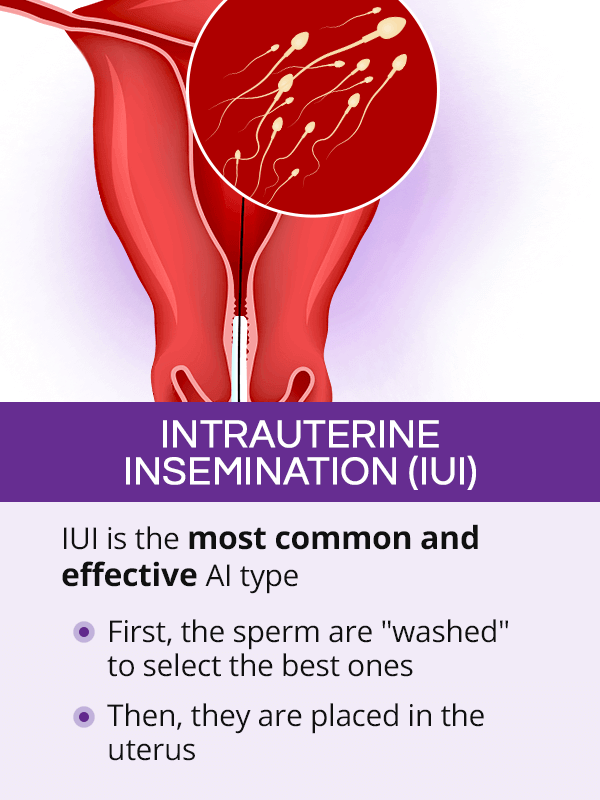
Intravaginal insemination, also referred to as self-insemination, consists of placing the semen in one's vagina close to the cervix using a needleless syringe. Since it can be done at home, it is a cost-effective option.
Women with ovulation problems might need to take fertility pills and injections aimed at stimulating ovulation to ensure that the egg is released prior to insemination. Although generally safe, some of these medications have been found to significantly increase the likelihood of multiple gestations.
Artificial Insemination Success Rates
The success rates of artificial insemination cycles are influenced by numerous factors, like a woman's age, the state of her ovarian reserve, ovulation patterns, sperm quality, and timing of the insemination itself.
Since IUI and ICI are the most common AI methods, reliable success rates are only available for these procedures:
IUI Success Rates
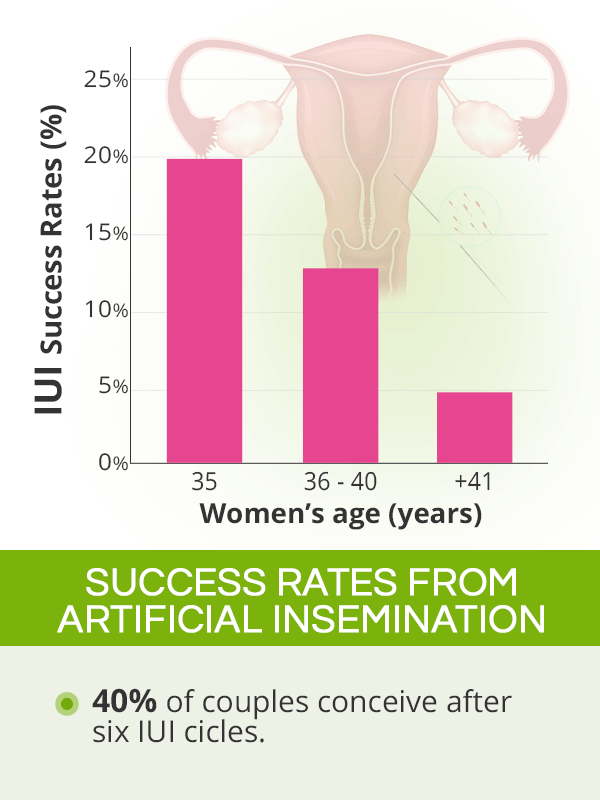
For women younger than 35, IUI is the most effective option with 15-20% pregnancy rates per cycle.
For women aged 35 to 40, there is a 10-13% success rate.
For those over 40, there is a 2-5% success rate.
About 40% of couples successfully get pregnant after six artificial fertilization cycles.
ICI Success Rates
ICI gives about 10-15% pregnancy chance per cycle for women younger than 35.
After six ICI cycles, 37.9% of women get pregnant.
Couples who have not conceived after six cycles are typically advised to explore other ART options, including in traditional vitro fertilization (IVF) or through intracytoplasmic sperm injection (ICSI).
Artificial Insemination Cost
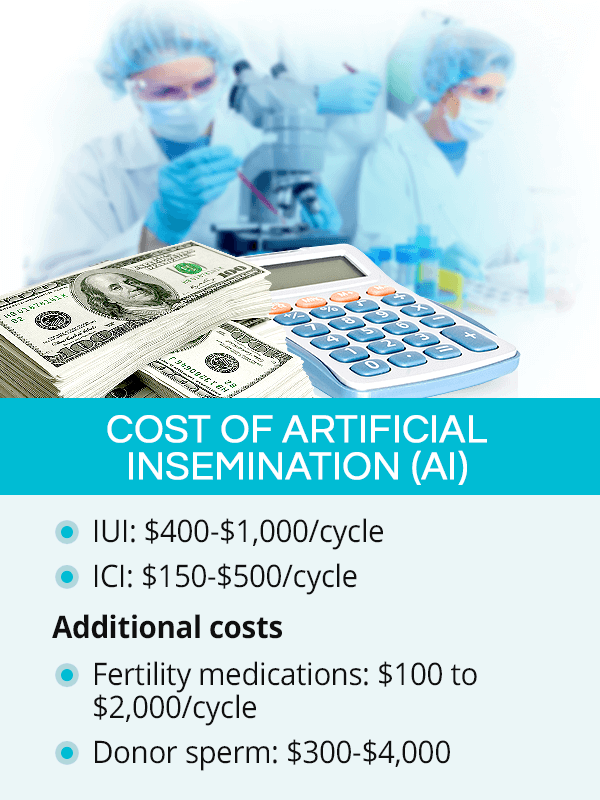
In comparison to IVF, AI is definitely a more affordable option. However, because most women need several cycles to get pregnant, and some might require medications for ovarian stimulation, the overall artificial insemination cost can quickly add up.
Intrauterine insemination costs about $400 - $1,000 per cycle, while intracervical insemination is slightly cheaper and can cost from $150 - $500 per cycle.
These costs do not include consultations, blood work, or medications to stimulate ovulation, which - depending on the type - can cost from $100 to $2,000 per cycle.
Sperm donation, which might range from $300 to $4,000, might be another additional cost.
Depending on individual plans, some insurance companies might cover a portion of artificial insemination costs.
Key Takeaways
For many couples who struggle getting pregnant naturally, artificial insemination might be the best option to achieve pregnancy as they explore the available infertility treatments. It aims to increase the chances of fertilization by depositing sperm closer to the egg during ovulation. A woman can undergo one of four types of artificial insemination, the two most common ones being intrauterine and intracervical insemination. AI procedures are considered safe and effective, though most couples need several insemination cycles to get pregnant. The more affordable artificial insemination cost comparing to IVF is another reason why AI is an attractive and popular method for resolving infertility and taking a step towards happy parenthood.
Sources
- American Pregnancy Association. (2019). Donor insemination. Retrieved March 21, 2019 from https://americanpregnancy.org/infertility/donor-insemination/
- Facts, Views & Vision. (2015). Artificial insemination history: hurdles and milestones. Retrieved March 21, 2019 from https://www.ncbi.nlm.nih.gov/pmc/articles/PMC4498171/
- Human Reproduction. (2015). Intrauterine insemination or intracervical insemination with cryopreserved donor sperm in the natural cycle: a cohort study. Retrieved March 21, 2019 from https://academic.oup.com/humrep/article/30/3/603/662550
- Medline Plus. (2017). Infertility. Retrieved March 21, 2019 from https://medlineplus.gov/infertility.html
- Transgenic Research. (2015). A rapid and effective nonsurgical artificial insemination protocol using the NSETtm device for sperm transfer in mice without anesthesia. Retrieved March 21, 2019 from https://www.ncbi.nlm.nih.gov/pmc/articles/PMC4504984/
- Office on Women's Health. (2019). Infertility. Retrieved March 21, 2019 from https://www.womenshealth.gov/a-z-topics/infertility
- Planned Parenthood. (n.d.). What is IUI? Retrieved March 21, 2019 from https://www.plannedparenthood.org/learn/pregnancy/fertility-treatments/what-iui
